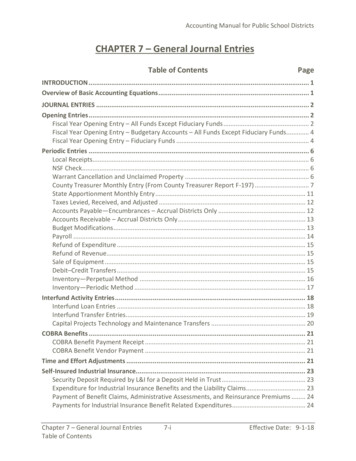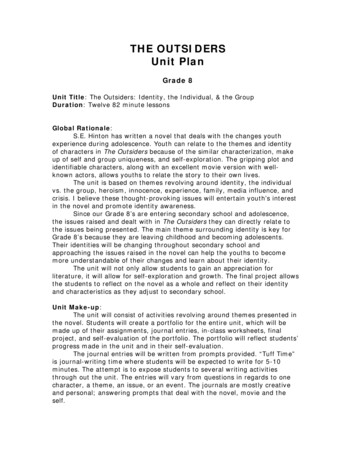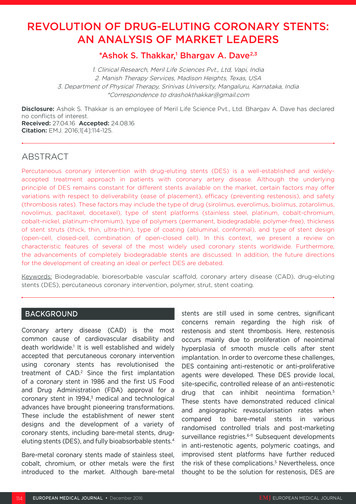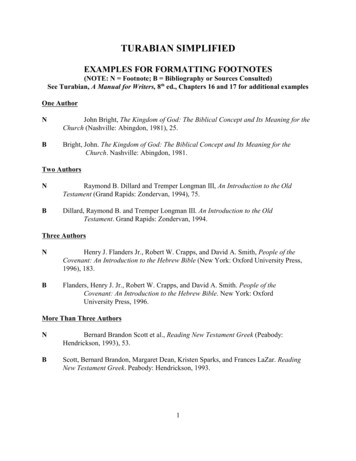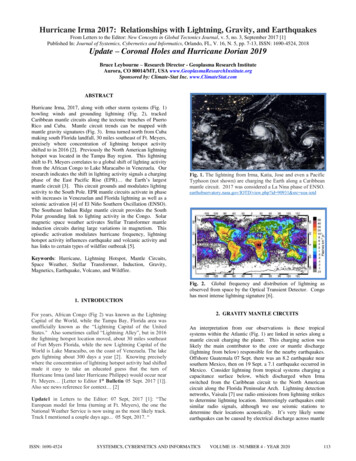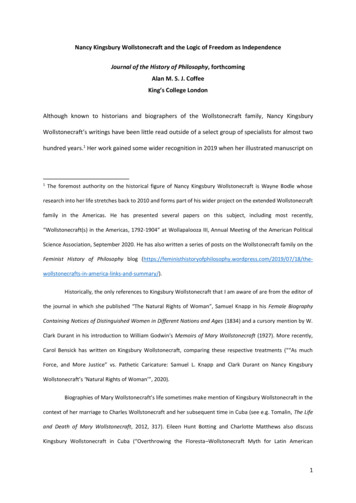
Transcription
Nancy Kingsbury Wollstonecraft and the Logic of Freedom as IndependenceJournal of the History of Philosophy, forthcomingAlan M. S. J. CoffeeKing’s College LondonAlthough known to historians and biographers of the Wollstonecraft family, Nancy KingsburyWollstonecraft’s writings have been little read outside of a select group of specialists for almost twohundred years.1 Her work gained some wider recognition in 2019 when her illustrated manuscript on1The foremost authority on the historical figure of Nancy Kingsbury Wollstonecraft is Wayne Bodle whoseresearch into her life stretches back to 2010 and forms part of his wider project on the extended Wollstonecraftfamily in the Americas. He has presented several papers on this subject, including most recently,“Wollstonecraft(s) in the Americas, 1792-1904” at Wollapalooza III, Annual Meeting of the American PoliticalScience Association, September 2020. He has also written a series of posts on the Wollstonecraft family on theFeminist History of Philosophy blog d-summary/).Historically, the only references to Kingsbury Wollstonecraft that I am aware of are from the editor ofthe journal in which she published “The Natural Rights of Woman”, Samuel Knapp in his Female BiographyContaining Notices of Distinguished Women in Different Nations and Ages (1834) and a cursory mention by W.Clark Durant in his introduction to William Godwin’s Memoirs of Mary Wollstonecraft (1927). More recently,Carol Bensick has written on Kingsbury Wollstonecraft, comparing these respective treatments (““As muchForce, and More Justice” vs. Pathetic Caricature: Samuel L. Knapp and Clark Durant on Nancy KingsburyWollstonecraft’s ‘Natural Rights of Woman’”, 2020).Biographies of Mary Wollstonecraft’s life sometimes make mention of Kingsbury Wollstonecraft in thecontext of her marriage to Charles Wollstonecraft and her subsequent time in Cuba (see e.g. Tomalin, The Lifeand Death of Mary Wollstonecraft, 2012, 317). Eileen Hunt Botting and Charlotte Matthews also discussKingsbury Wollstonecraft in Cuba (“Overthrowing the Floresta–Wollstonecraft Myth for Latin American1
Specimens of the Plants and Fruits of the Island of Cuba resurfaced.2 This led to the sharing on socialmedia of Kingsbury’s article on “The Natural Rights of Woman”, bringing this work to a much wideraudience for the first time in recent history.3 Part of the attraction for many of those who encounteredthis essay was surely the curiosity factor of reading a treatment of the rights of woman by ‘anotherWollstonecraft’. Certainly, that was the case for me. It does not take one more than a few paragraphs,however, to realise that Kingsbury speaks with her own assured and forthright voice, presenting adistinctive and penetrating analysis that is fully deserving of sustained scholarly attention in its ownright.Though Kingsbury’s interests were broad – encompassing biology and natural history as wellas literature and philosophy – my focus here is on her political philosophy. I examine only one aspectthat we can discern from “The Natural Rights of Woman”. Although I have said that Kingsbury’s workstands on its own, irrespective of comparison with her more famous sister-in-law, I nevertheless placeher in dialogue with Mary Wollstonecraft, identifying in Kingsbury a bridge connectingWollstonecraft’s innovations of the late eighteenth century with later emancipatory thought towardsthe end of the nineteenth century. In doing this, my interest in her work is purely analytical. I treatKingsbury as a philosopher in her own right and make no biographical claims about the possibleFeminism”, 2014, 79.) Finally, the resurfacing of Kingsbury Wollstonecraft’s Cuban manuscripts was covered ina few online articles, including by Jose Beduya (“Botanical illustration pioneer goes from obscurity to online”,2019), Jonathan Carey (“A Forgotten Botanist’s Stunning 19th-Century Manuscript Is Now Online”, 2019) andCzerne Reid (“‘Lost’ book of exquisite scientific drawings rediscovered after 190 years”, 2019).2Beduya, “Botanical illustration pioneer goes from obscurity to online”.3Nancy Kingsbury Wollstonecraft 1825, “The Natural Rights of Woman”.2
influence Wollstonecraft may have had on her thinking.4 This much said, whether or not there is acausal connection, there is a clear resonance between themes invoked by both writers that I believeis worth examining. To avoid confusion, I shall refer to Nancy Wollstonecraft by her premarital name,Kingsbury, reserving ‘Wollstonecraft’ for Mary Wollstonecraft.Kingsbury’s article is framed to address what appears to be a puzzling question. Why, she asks,in the early nineteenth century in America, when there are historically unparalleled opportunities forwomen to improve their minds – both formally through education and informally by reading orengaging in cultural activities – do so few take advantage of this? Indeed, she further observes, associety grows more affluent and they have more leisure time, women seem all the more to seek theshallow and fleeting pleasures that are aimed at pleasing men, polishing their manners and remainingignorant. This perception fed into the popular prevailing prejudice that women were not in fact men’sintellectual and moral equals but that they were, rather, created to rely on the support of men.Kingsbury does not deny that there were greater opportunities for self-improvement which womenseem to have squandered. Instead, she locates the issue to be addressed at a structural level.Whatever opportunities there are for women’s education are negated by deeper and more pervasivesocial practices, norms and institutions. The result is that the choices women end up making, eventhough they may appear paradoxical or suboptimal, are rational responses to the complex but oftenunperceived realities of their subjection.In framing her argument, Kingsbury both picks up on themes developed by Wollstonecraftand makes use of several of the same conceptual tools. In what follows, I place Wollstonecraft withinthe republican political tradition, although it is not necessary to endorse that label to follow my4There is evidence that Kingsbury sometimes used the name ‘Mary Wollstonecraft’ to refer to herself. Bodleindicates that Kingsbury may have travelled under her predecessor’s name and that is how the editor of theBoston Monthly, in which she published, seems to have known her (as I discuss below). How far this interest inWollstonecraft influenced Kingsbury’s philosophy directly is not a question I can pursue in this article.3
analysis.5 All that is required here is to accept that Wollstonecraft employs a cluster of connected ideasthat centre around the notions of independence, equality, virtue and the common good which relateto each other in a particular way. Kingsbury’s work, similarly, makes use of this framework.Accordingly, I will make use of a republican logic of freedom as independence in analysing Kingsbury’stexts.I should emphasise that my use of the philosophical logic does not of itself imply thatKingsbury’s personal political views were themselves ‘republican’ in the broader sense (Bodle, forexample, characterises Kingsbury as having monarchist sympathies). It is not, therefore, my intentionto classify Kingsbury as a ‘republican philosopher’, nor indeed to give her any particular label such asfeminist or education theorist although her work engages with these areas. Rather, my purpose is toidentify and follow her use of the particular logic of independence as a function of equality, virtue andthe common good, and to place this in the context of both Wollstonecraft’s earlier and FrederickDouglass’s later applications. I am not aware of any other philosophical treatments given toKingsbury’s work and so I leave it for others to provide fuller accounts of her intellectual repertoire.In focusing on the logic of independence, I set aside any investigation of Kingsbury’s personalattitudes. In so doing, I draw parallels between her conclusions about the socially structural nature ofwomen’s subjection with those developed by Douglass in the context of race. This does not mean thatKingsbury herself was consistent in her personal beliefs on the issues of both sex and race. I am not ina position to make any claims of my own in this regard and will concentrate only on the logic of theprinciples that Wollstonecraft, Kingsbury and Douglass use and develop. However, I shall providesome background into the complexities of the Wollstonecraft family on the question of slavery and5Several recent writers have argued that Wollstonecraft made extensive use of republican concepts across herwriting. See especially Bergès 2019, “Women, Revolutions and Republicanism”; Coffee 2014, “Freedom asIndependence: Mary Wollstonecraft and the Grand Blessing of Life”; Halldenius 2015, Mary Wollstonecraft andFeminist Republicanism. See also Botting 2016, Wollstonecraft, Mill, and Women's Human Rights.4
race, and which may implicate Kingsbury herself, drawing in particular on the scholarship of EileenHunt.The structure of the paper is as follows. In the first section, I give a short biographical accountof Kingsbury and her writing by way of orientation for unfamiliar readers. In the second section, Icontinue with this biographical focus, discussing the application of Kingsbury’s and Wollstonecraft’sarguments for gender equality to the issue of racial-equality. In section three, I turn to the foundationsof Wollstonecraft’s philosophy, briefly outlining the Wollstonecraftian themes and concepts uponwhich I shall draw in my analysis of Kingsbury. I focus particularly on the relationship between the fourkey values outlined above in her work: freedom as independence, equality, virtue, and the commongood. In section four, I establish the foundations of the position I ascribe to Kingsbury, drawing on twoof her articles, “Patriotism: A Sketch” and “Books and Literature”. I discuss the role played by three ofthe values I identified in Wollstonecraft: independence, virtue and the common good. In the fifthsection, I turn to the “Natural Rights of Woman” itself, examining the ideal of equality, especially inthe sense of women’s mental equality with men, and focusing particularly on the systematic andwholesale denial of opportunities for developing their intellectual capacities that women experience.In section six, I examine the corrupting effect that inequality has on virtue, which in turn underminesthe collective commitment to the common good and thereby of the conditions necessary for socialfreedom. In section seven, I bring together Kingsbury’s arguments, showing how restoring women’snatural intellectual equality is not simply a matter of educational reform, and nor is it a function ofindividual choice. Instead it requires a holistic approach that entails the regeneration of social, politicaland economic relations between the sexes. Finally, in the concluding section, I very briefly placeKingsbury’s arguments within a trend within the nineteenth century that develops Wollstonecraft’s5
arguments and builds toward the later emancipatory thought of Frederick Douglass, who it has beenargued employs a Wollstonecraftian philosophical scheme. 6Nancy Kingsbury WollstonecraftNancy Kingsbury was born in 1791 in New Hampshire in the small town of Rindge, not far from theborder with Massachusetts.7 In 1813 she married Wollstonecraft’s youngest brother, Charles (17701817), who had left England for America in 1792 in order to improve his prospects.8 Following Charles’sdeath in 1817, Kingsbury moved to Matanzas, Cuba where she wrote her three-volume manuscript onthe island’s plants and fruits. It was intricately and beautifully illustrated by herself, something whichhas attracted considerable praise by her twenty-first century admirers. Sadly, Kingsbury died of fevershortly after sending her book to publishers aged only 36 (incidentally, a similar age to Wollstonecraftherself, who died at 38). It is, however, said to be one of the earliest and most comprehensive pictorialaccounts of Cuban plant life in existence.9 Self-taught, as we would expect of a woman of the time,Kingsbury was nevertheless an astute botanist and natural historian. She had earlier published a seriesof wide ranging observations and reflections of Cuba’s culture and geography, written as two “Lettersfrom Cuba” in the Boston Monthly Magazine, which was the same journal in which she had earlier6For example, Coffee 2020, “A Radical Revolution in Thought: Frederick Douglass on the Slave’s Perspective onRepublican Freedom”.7Kingsbury is usually given as having been born in Rindge. Bodle, however, locates her place of birth as Walpole,Massachusetts based on his examination of her birth records (private correspondence).8Wollstonecraft had confided her friend of her profligate brother, that “it is not easy to procure a situation fora young man who has nothing to recommend him”. She later added that Thomas Paine had replied that, onceCharles had started to apply himself, it would “do him no harm in America” (The Collected Letters of MaryWollstonecraft, 2003, 192, 203).9Jonathan Carey 2019, “A Forgotten Botanist’s Stunning 19th-Century Manuscript is Now Online”.6
published the “Natural Rights of Woman”.10 Amongst her fascinating discussions, Kingsbury concludesfrom an examination of the local geology that, contrary to the prevailing opinion, that Cuba “has beenformed from the ocean and not disjoined from the continent”.11 She adds that “I am more inclined tobelieve that the West India Isles will join the continent at some future period than I am to think theyhave made part of it in times past. But this I suppose would be laughed at” as vague and speculative.As it turns out, the Caribbean and South American plates are, indeed, converging (though, of course,the modern theory of plate tectonics was not available to her).That Kingsbury’s work was lost to public view for so long is not entirely surprising or unusual.The combination of the difficult spelling of her married surname and the standard of nineteenthcentury record keeping is problem enough. Her Cuban manuscript was, for example, originally listedunder the name ‘Wollstonecroft’.12 Furthermore, Kingsbury is more commonly referred to today asAnne rather than Nancy. Bodle believes this to be a mistake, perhaps based on the assumption thatNancy was historically often a diminutive of Anne even though by the nineteenth century it was alsoa name in its own right. He believes that a mistake was made in the clerical records in Cornellsometime after the receipt of her manuscript. The volumes remain attributed to Anne KingsburyWollstonecraft today. A more general, and often more serious, problem of identity that she shareswith many historic women writers, was that Kingsbury often wrote under a pseudonym. The threearticles for the Boston Monthly that I discuss were written under the name D’Anville whereas her twoCuban letters are simply attributed to “a person of great observation and accomplishments”.13 Afurther complication, particular to Kingsbury, was the tendency for her to be confused or conflated10Kingsbury 1826, “Letters from Cuba . No. 1” and “Letters from Cuba . No. 2”.11Letters No. 2, 642.12Czerne Reid 2019, “‘Lost’ book of exquisite scientific drawings rediscovered after 190 years”.13Letters No. 1, 561.7
(possibly deliberately on her part) with her more famous namesake. When the editor of the BostonMonthly, Samuel Knapp, later revealed the identity of D’Anville in an entry to an anthology ofdistinguished women that he was compiling, he gave it as Mary Wollstonecraft (misspelled asWollstoncraft).14 A century later, Kingsbury was the subject of a brief and dismissive discussion in W.Clark Durant’s introduction to a reprinting of Godwin’s Memoirs of Wollstonecraft, although hereferred to her simply as Mrs Wollstonecraft.15 Beyond these obscure and oblique references,however, there is scant mention of Kingsbury or her work in the historical and scholarly record.16Durant’s unfavourable comparison of Kingsbury with Wollstonecraft is born of ignorance – hehad apparently not read Kingsbury’s papers – as well as some sexist presumptions about Kingsbury’slikely motives for having written a similarly titled treatment of women’s rights. He assumed that shehad simply produced an inferior copy of the original.17 As I hope to show, Knapp’s assessment is moreaccurate. She was, he maintained, a powerful and penetrating thinker who wrote with “pith andpoint”.18 Moreover, far from copying Wollstonecraft, Kingsbury engaged deeply with the same themesand drew upon a similar range of concepts to produce her own innovative and distinctive position.Gender, Race and the Universal Scope of Freedom as IndependenceIn arguing that Kingsbury employed, and then extended, concepts that Wollstonecraft used, my focusis on the particular ideal of freedom as independence, as I set this out in the next section. The principal14Samuel Knapp 1834, A Female Biography Containing Notices of Distinguished Women in Different Nations andAges, 477-79. For a detailed and insightful discussion, see Carol Bensick, “Knapp and Durant”.15William Godwin (1927), Memoirs of Mary Wollstonecraft.16See Bensick Knapp and Durant”.17Bensick, “Knapp and Durant”.18Bensick, “Knapp and Durant”.8
application of this notion in both Wollstonecraft and Kingsbury is that of women’s natural and civilrights. The republican logic that dependence undermines the civic virtue necessary for a free andstable society is not confined to any specific social groups, and as we shall see, Wollstonecraft andKingsbury both couch their claims in general terms at times. In the final sections, however, I shall showhow Frederick Douglass picks up on the same logic implied by the principle of freedom asindependence applying it to the issue of racial equality. Kingsbury herself did not, to my knowledge,write in any detail on the matter of race and so I cannot speculate on what her personal views on thisissue were. Accordingly, my concern here is solely with the logic that emerges from the philosophicalprinciples Kingsbury develops.19In Wollstonecraft’s case, the extension of her arguments for women’s independence to theissue of race can be justified more readily not only theoretically but also both textually andcontextually. It is important to remember, Eileen Hunt reminds us, that (as so often with women inthe history of philosophy) “we have an incomplete corpus of writings for Wollstonecraft” since manyof her writings were either anonymously written or destroyed by relatives after her death.20Nevertheless, there is ample evidence of her condemnation of racial slavery on republican grounds in19On a biographical note, there has been some speculation that Kingsbury was the beneficiary of slave labour.Bodle, for example, notes that the estate of Kingsbury’s husband Charles Wollstonecraft, “included severalenslaved people in late 1810s urban New Orleans”, adding that this is “surely one of the more demoralizingfindings of Wollstonecraft scholarship” (2019, “Charles Wollstonecraft”). Bensick goes on to argue, plausibly ifinconclusively, that Kingsbury may have had connections to slaveholders in Cuba (“Knapp and Durant”).20Writing as Eileen Hunt Botting (2021, “Wollstonecraft in Jamaica: the international reception of A Vindicationof the Rights of Men in the Kingston Daily Advertiser in 1791”, 8). She adds that “most of [Wollstonecraft’s]unpublished papers seem to have been destroyed after her death in 1797 by her relatives, beginning with herhusband William Godwin and extending to her grandson Percy Florence Shelley and his wife Jane whobequeathed a portion of the family papers to Oxford’s Bodleian Library”.9
the writings that we do have. In A Vindication of the Rights of Woman, for example, Wollstonecraftlikens the condition of women to that of racially-based chattel slaves, using the conceptual languageof freedom as independence as we will discuss it in the next section (“is one half of the human species,like the poor African slaves, to be subject to prejudices that brutalize them, when principles would bea surer guard”).21 Although Wollstonecraft never develops a sustained application for a racially equalsociety in the terms that she does for gender, this passage is evidence that she recognised that thesame basic principles were at work regarding the logic of dependence. Hunt identifies a “universalistic,theologically-informed” principle of human beings as free and rational agents made in God’s image inWollstonecraft’s writing.22 I agree but add that this is worked out through the framework ofindependence. Hunt nuances her conclusion by observing that Wollstonecraft often employ an‘Orientalist’ language, especially in identifying Muslim societies as exemplars of those that havesuffered the corruption that follows authoritarian regimes.23 The extent to which this is an issue inWollstonecraft’s thought deserves greater treatment than I can give it here. However, it is anindication of the pervasive nature of background cultural assumptions that Wollstonecraft herself issensitive to when she notes that “men and women must be educated, in a great degree, by theopinions and manners of the society they live in. In every age there has been a stream of popularopinion that has carried all before it, and given a family character, as it were, to the century”.24 This21Wollstonecraft 2014, 174. A few lines above, Wollstonecraft describes the slave trade as an “abominabletraffick”.22Botting, “Wollstonecraft in Jamaica”, 3. See also Botting 2020, “From revolutionary Paris to Nootka Sound toSaint-Domingue: The international politics and prejudice behind Wollstonecraft’s theory of the rights ofhumanity, 1789–91”, 2 (“Across Wollstonecraft’s writings from 1788 to 1792, the “rights of humanity” became—at least in theory—the moral and political entitlement of people of any “nation,” “color,” “sex,” or “rank””).23Botting, “From Nootka Sound to Saint-Domingue” (3-4, and especially 15-17).24Wollstonecraft, A Vindication of the Rights of Woman (47).10
thought also underpins the call for a radical revolution in thought that I go on to attribute to Douglassin the final section.Hunt also highlights how several of the anonymous book reviews that Wollstonecraft wroteas a staff writer for the Analytical Review were on “topics related to the social and political conditionsof “Indian” and “slave” peoples of the Americas” including, most prominently, her review of thefreedman and abolitionist Olaudah Equiano’s slave narrative.25 One of the most interesting, andperhaps telling, indications of Wollstonecraft’s consistency in applying the same principles of freedomand independence to the question of race-based slavery as she does to women’s social subordinationcan be seen in the reception of her Vindication of the Rights of Men (1790) in the sugar-producingcolony of Jamaica.26 Hunt has recently shown that the prominent Jamaican newspaper, the KingstonDaily Advertiser, published several articles on Wollstonecraft’s book, including a lengthy extract thatruns to 1,660 words. In this extract, Wollstonecraft not only explicitly condemns slavery (“Hell stalksabroad;–the lash resounds on the slave's naked sides”) – something notable in a newspaper thatserved the interests of the plantation owners – but in building her case, she draws on the elements ofthe conception of freedom as independence that I will outline in the next section.2725The Interesting Narrative of the Life of Olaudah Equiano, or Gustavus Vassa, the African. Written by Himself(1789, see Botting 2020, “From Nootka Sound to Saint-Domingue”, 9). Botting identifies eight of Wollstonecraft’sreviews as concerning native and slave peoples in the Americas, following the work of Janet Todd and MarilynButler (The Works of Mary Wollstonecraft, volume 7, pp. 50, 100, 168, 185, 332, 355, 375, 390).2627Botting 2021, “Wollstonecraft in Jamaica”.For example, the extract begins with a condemnation of Burke’s praise of the concept of ‘naturalsubordination’, which to a republican represents arbitrary power and the antithesis of freedom. Such a blindsubmission does not serve the common interest but rather leads to tyranny which undermines civic virtue.Wollstonecraft calls for the break-up of large estates which would enable independence amongst the poor.11
The Foundations of Mary Wollstonecraft’s ThoughtThere are many ways to approach Wollstonecraft’s philosophy. One way that I believe is helpful, isthrough the central role that a small cluster of concepts play in shaping her arguments. These includefreedom, understood as independence from arbitrary forms of controlling power; equality, notionallyof political and social status but also entailing a high degree of material equality; and virtue, a keycomponent of which implies a willingness and a capacity to guide one’s conduct according to thedictates of reason.28 Taken together, these three values give rise to an ideal of the common good,understood inclusively to represent the genuine shared interests of all members of society, includingthose of both women and men but also cutting across racial, religious and class divisions.29In emphasising these particular values, which are all connected in Wollstonecraft’s thought, anumber of scholars have identified her as writing within the republican tradition of politicalphilosophy.30 In my view this is has many advantages. Certainly, Wollstonecraft makes explicit andprominent use of republican themes in Vindication of the Rights of Men (1790) and in the History of“Virtue”, which is necessary for freedom, “can only flourish amongst equals”, whereas those who live insubmission and dependence, “are radically degraded by the habits of their life”. The extract can be found onBotting 2021, 5 and in Wollstonecraft 1995, 58-62.28See, for example, Coffee 2013, “Mary Wollstonecraft, Freedom and the Enduring Power of Social Domination”and 2014 “Freedom as Independence”; Halldenius, Feminist Republicanism; Bergès, “Women, Revolutions andRepublicanism”.29Coffee 2016, “Freedom, Diversity and the Virtuous Republic”; Halldenius (2016), “Representation in MaryWollstonecraft’s Political Philosophy”.30In addition to the references in the two preceding notes, see also Bergès 2016, “Wet Nursing and PoliticalParticipation” and Susan James 2016, “Mary Wollstonecraft’s Conception of Rights”. Also Botting,Wollstonecraft, Mill, and Women's Human Rights.12
the French Revolution (1794). Placing her within this tradition allows us to connect Wollstonecraft’sthought with the wider arc of revolutionary and emancipatory thinking that spans the late eighteenthand nineteenth centuries. This helps us place Wollstonecraft in dialogue with women writing indifferent contexts and times but drawing on a shared overarching set of political concepts, includingCatharine Macaulay, Olympe de Gouges in revolutionary France, and writers such as Frances Wrightin early nineteenth century USA, the intellectual context in which Kingsbury herself was located.31 Italso provides one point of contact through which to discuss the common aims that linkedWollstonecraft and other feminist philosophers with emancipatory groups such as abolitionists andcampaigners for racial equality throughout the nineteenth century.32 An additional benefit of readingWollstonecraft as writing within this broader context is that it gives lie to the claim that republicanismis solely a patriarchal approach constructed wholly by male philosophers without any female input.33Neither should contemporary feminist republicanism be seen simply an ahistorical attempt to rescuea masculine philosophy. On the contrary, women such as Wollstonecraft have theorised within thebasic framework of freedom understood as independence, equality and virtue in considerablenumbers over a sustained historical period, challenging its received masculine assumptions.3431Bergès “Women, Revolutions and Republicanism”; On Wollstonecraft’s influence on American feminism in thenineteenth century, including from a republican perspective, see Botting 2013, “Making an American FeministIcon: Mary Wollstonecraft's Reception in US Newspapers, 1800-1869”; Botting and Matthews 2014,“Overthrowing the Floresta–Wollstonecraft Myth for Latin American Feminism”; Falchi, Federica 2016, “FrancesWright: Liberty as Founding Principle of Republican America”.32Coffee “Radical Revolution in Thought”.33Green 2019, “On the Philosophical Significance of Eighteenth-Century Female ‘Republicans’”.34Bergès, “Women, Revolutions and Republicanism”, Coffee “Women and the History of Republicanism”.13
One of Wollstonecraft’s most important philosophical innovations, it has been argued, is theway she rearticulates the standard notion of republicanism as political ideal as a social one.35 If theclassic republican slogan was, historically, that ‘freedom is only possible in a free state’, Wollstonecraftamends it to read that ‘freedom is only possible in a free (inclusive and representative) culture’. Ourpolitical freedoms, she argues, are dependent on, and derivative from, our social freedoms – from theway that we are perceived, valued, judged socially. Wollstonecraft’s innovation, albeit one built onthe ground laid by Catharine Macaulay before her, was to apply the same structure of freedom thatrepublicans ascribe to political institutions to the general culture as well. Wollstonecraft’s argumentswere developed in the context of women’s rights, and rightly this is where they have had mostinfluence. Nevertheless, as an analysis of the social and cultural threats to freedom, they clearly alsohave great purchase on the question of racial inclusion within the political community on equal terms.In this context, it has been shown that Wollstonecraft’s early
Clark Durant in his introduction to William Godwin [s Memoirs of Mary Wollstonecraft (1927). More recently, arol ensick has written on Kingsbury Wollstonecraft, comparing these respective treatments (As much Force, and More Justice _ vs. Pathetic aricature: Samuel L.







